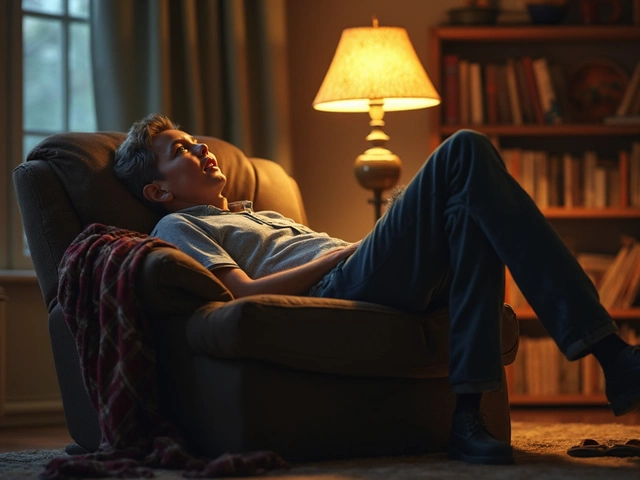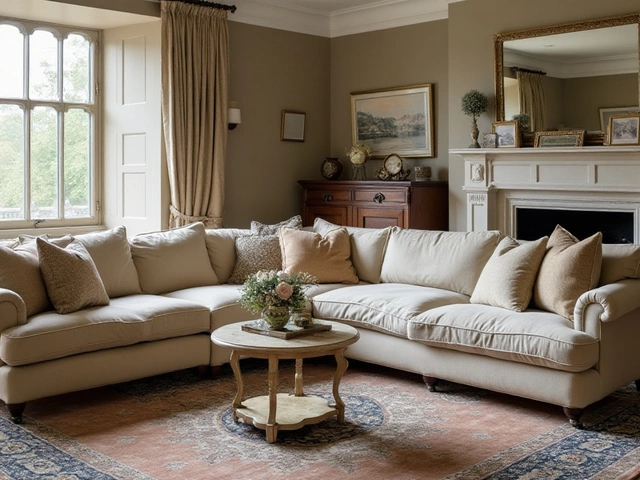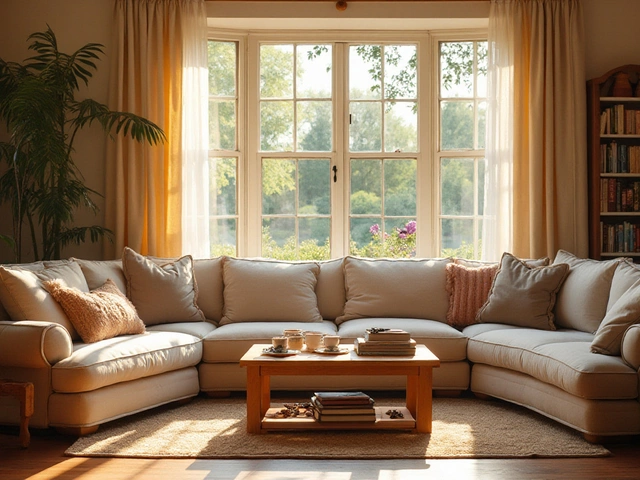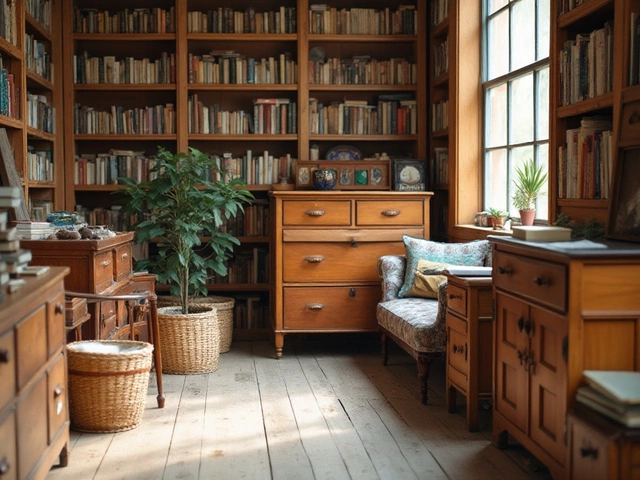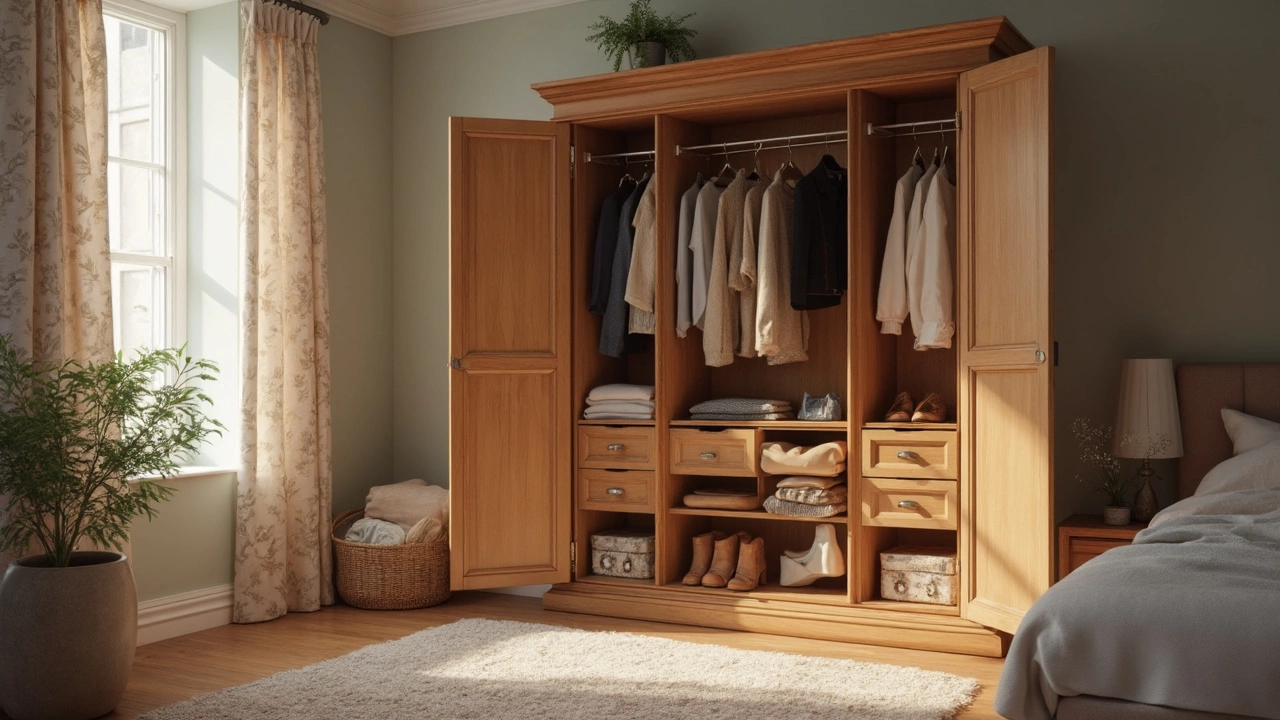 6
May,2025
6
May,2025
Ever found yourself staring at a heavy piece of furniture and thinking, wait, is this even a wardrobe or just a big cabinet? You’re not alone. Plenty of people mix up wardrobes, closets, and dressers, even though they serve totally different roles in the home.
Here’s the basic deal: a wardrobe isn’t just any old box for shoving clothes in. It’s usually a freestanding piece of furniture that’s made for hanging, folding, and sometimes hiding clothes and accessories from view. The design matters—a rod for hangers, shelves for knits, maybe a drawer or two for socks and underwear. No rod, no shelves, no dice—it’s just a cupboard at that point.
But why does it even matter? Well, if you’re trying to sort out your space or finally upgrade from the chair-pile system, knowing what counts as a wardrobe can actually save you time, money, and a bunch of headaches. Each type brings something different to the storage game, so it pays to know exactly what you’ve got (or need).
- So, What Is a Wardrobe Really?
- Wardrobe vs. Closet vs. Dresser
- Key Features to Look For
- Smart Tips for Organizing Any Wardrobe
So, What Is a Wardrobe Really?
A wardrobe isn’t just a box with a door—it’s built with your clothes in mind. It’s all about storing clothes in a way that keeps them tidy, easy-to-find, and, let’s be real, not crumpled into a wrinkled mess. Most classic wardrobes give you space to hang shirts, dresses, or anything you’d like to keep off the floor and wrinkle-free.
The big difference? A wardrobe is usually a freestanding piece of furniture, so you can move it without calling a contractor. The earliest special wardrobes popped up in Europe around the 17th century. Back then, the rich needed somewhere for their endless layers of clothing—think puffy shirts and long coats—so they had wooden cabinets specially made just for that.
Modern wardrobes usually have a few things in common:
- A tall hanging section with a sturdy rod for hangers
- Shelves for folded stuff like sweaters, jeans, and T-shirts
- Drawers (sometimes) for the little things: socks, underwear, maybe belts
The standard wardrobe isn’t just for bedrooms, either. People use them in hallways, guest rooms, and even basements, wherever extra clothes organization is needed.
Need a little real-world perspective? IKEA reported in 2023 that their PAX wardrobe system was one of the top five biggest sellers globally, showing just how universal the need for practical clothes storage has become.
Wardrobe vs. Closet vs. Dresser
If you search online for wardrobe, half the results show closets and dressers too. But they're not the same thing. The main difference is how and where you use them for storing clothes.
- Wardrobe: This is usually a big, freestanding piece of furniture you can move around. Inside, you’ll find a rod or bar to hang shirts and dresses, shelves for folded pants or sweaters, and sometimes drawers at the bottom. The point is, it’s all-in-one—hang, stack, and stash.
- Closet: A closet is part of the house itself—it's built-in, not free-standing. Closets can be tiny or massive (think walk-in), but they’re not something you can buy at IKEA and drag home. People tend to add shelving or custom organizers to suit their needs, but the structure stays put.
- Dresser: Dressers (also called chests of drawers) are mostly for stuff you fold: T-shirts, socks, underwear, jeans. You won't find a rod for hanging anything—just drawers. They're more compact and fit just about anywhere you put them.
Here’s a clear comparison to break it down:
| Wardrobe | Closet | Dresser | |
|---|---|---|---|
| Freestanding | Yes | No | Yes |
| Hanging Space | Yes | Usually | No |
| Shelves | Often | Optional | No |
| Drawers | Sometimes | Optional | Yes |
| Customizable | Somewhat | Very | No |
For renters, a wardrobe is a lifesaver since you can set it up wherever and take it when moving. If you own your place and want a big storage upgrade, a built-in closet with organizers is hard to beat. Dressers fill in the gaps, holding anything that doesn’t need to go on a hanger. Mixing pieces is totally normal, and most homes use all three in some combo to keep chaos under control.
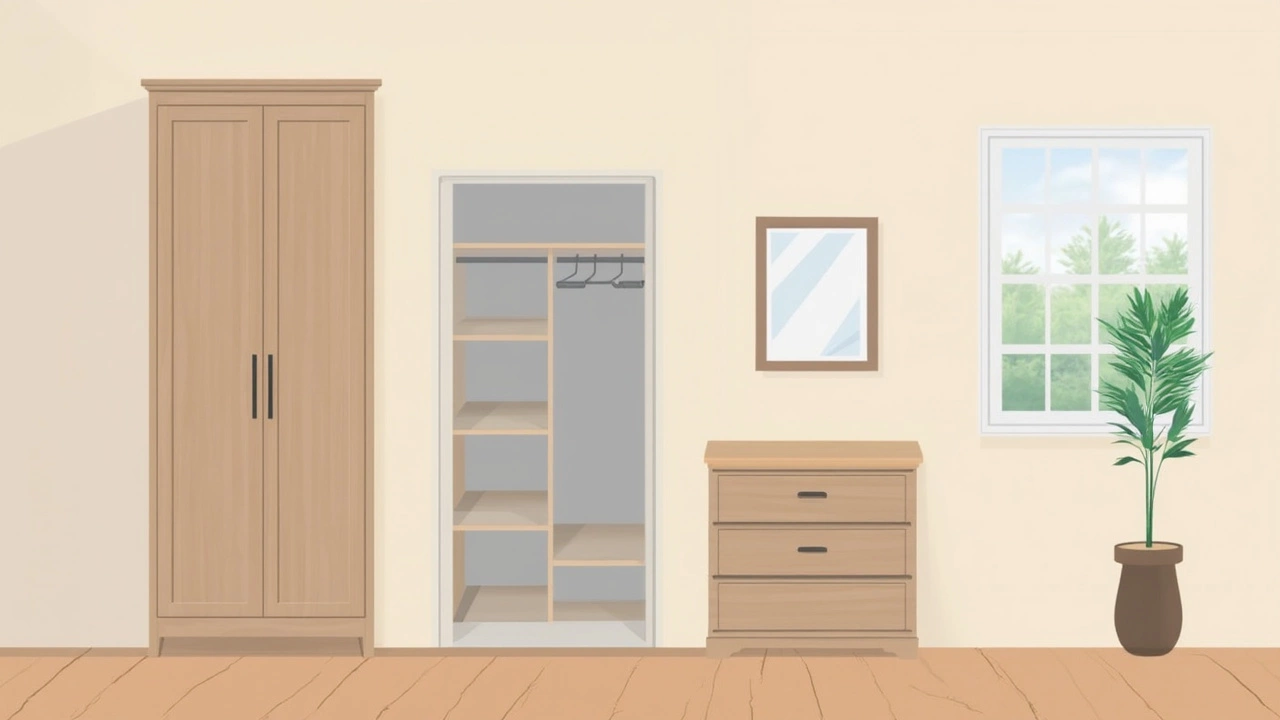
Key Features to Look For
If the goal is to find a solid wardrobe, there are details that make one truly useful. It's way more than just having doors that close. To start, a real wardrobe needs a solid hanging rail. No one wants a bar that sags under the weight of winter coats. A metal rail is best if you plan to keep heavier stuff—wood’s fine for lighter loads.
Shelves are next. Adjustable shelves are the holy grail because everyone’s got different clothes. Some people want to stack jeans and sweaters, others need spots for hats or storage bins. Look for at least two shelves, but more is never a bad thing. Built-in drawers give bonus points, especially if socks and underwear always seem to vanish in your house.
Don't forget materials. Wardrobes made from solid wood (like oak or pine) last way longer and look better, but can be heavier and pricier. Laminates or plywood are lighter, more affordable, and easier to move, but may not survive years of rough treatment. Pick what fits your style, your budget, and how often you move.
Doors can swing open or slide. Hinged doors need space out front; sliding doors are a life saver in tight rooms. Think about your room layout! And when it comes to storage, some modern wardrobes even include built-in lighting, which is a game changer if your room is dim.
If you want something extra, some wardrobes come with full-length mirrors, which can save you space and cash if you weren’t planning on buying a separate mirror. Here’s a quick look at features to zero in on:
- Strong hanging rail—preferably metal for durability
- Adjustable or multiple shelves
- Internal drawers for small clothes organization
- Solid frame—solid wood for strength, or laminated for price and weight
- Integrated lighting or mirrors for bonus practicality
- Sliding versus hinged doors depending on room size
"Think about your day-to-day use. Good wardrobes aren’t just pretty, they solve small problems every single day." — John Sims, Storage Furniture Specialist, 2024 interview with Home & Life Magazine
According to a British home furniture survey in 2023, 68% of shoppers said adjustable shelving was their top priority when buying a new wardrobe, beating out both material and whether or not it came with a mirror.
Smart Tips for Organizing Any Wardrobe
If your wardrobe is a mess, getting it sorted doesn’t have to be complicated or boring. Here’s what actually works when you want your clothes organization to stay tidy and make daily life a little smoother.
- Empty Everything Out: Grab it all—even the random socks in the back. It’s easier to see what you have and what you never wear when it’s all laid out.
- Sort by Category: Pile up shirts, jeans, work outfits, and keep accessories off to the side. If you can, split clothes by season so you only keep what’s current up front.
- Declutter (and Be Honest): That pair of jeans you haven’t worn since 2022? Time to donate or toss. Experts say most people only wear about 20% of what’s in their closet regularly.
- Choose the Right Hangers: Keep things looking neat and prevent weird shoulder bumps. Skinny velvet hangers save a ton of space in smaller wardrobes.
- Use Boxes or Bins for Small Stuff: Underwear, belts, or scarves quickly spiral into chaos. Tuck these items into small boxes or baskets on your shelves.
- Store Vertically, Not Horizontally: Fold sweaters and shirts upright in drawers or clear bins. It makes everything easy to spot—no more digging at the bottom.
- Label as You Go: If you share your wardrobe or have kids, labels keep everyone from tossing things in the wrong place.
If you’re into numbers, here’s something real: according to a well-known home organization study, the average person spends about 16 minutes a day deciding what to wear. Getting your wardrobe in shape can cut that time down by almost half. That’s two extra hours every week you could spend on literally anything else.
| Action | Potential Time Saved per Week |
|---|---|
| Basic tidy-up | ~1 hour |
| Full declutter + organization | 2-3 hours |
| Adding bins & labels | Extra 30 minutes |
Don’t forget: adjusting your setup when the seasons change (or when you buy new stuff) helps you get the most out of your storage. All it takes is a little effort up front—and your mornings will run a whole lot smoother.

